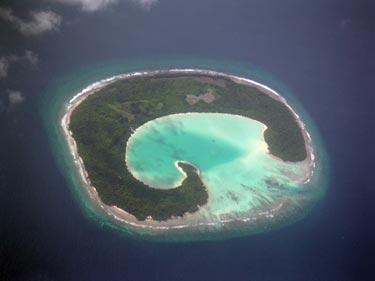Tiempo Climate Cyberlibrary
The World's Fragile Islands
 |
Agnès Sinaï argues that, from the
low-lying point of view of Pacific islanders or
circumpolar-dwelling Inuit, the Kyoto Protocol seems
an exploitative deal.
|
|
The author is a freelance journalist. She is
co-author, with Yves Cochet, of Sauver la Terre
(Fayard, Paris 2003).
|
Some 600 idyllic islands in the South Pacific make up
Micronesia; perhaps not so idyllic any more, as in recent
years half of the 150,000 inhabitants have had their houses
damaged or destroyed by storms more frequent and violent
than before. Sea levels rose in the region through the
second half of the 20th century, and this, linked with
exceptionally high tides and unpredictable rain,
exacerbated the intensity of the storms. As coastal erosion
increases, salt creeps into the water table and ruins
plantations, while rising temperatures nurture parasites
that attack copra plants.
Joseph Komo, a member of the official Micronesian
delegation to the Ninth Conference of the Parties to the
United Nations Framework Convention on Climate Change
(UNFCCC) in Milan, Italy, December 2003, says: “We are
the first people to die as a direct result of climate
change”. He went to Milan to plead with the
international community to speed up the release of promised
funds for vulnerable countries to protect themselves from
the effects of global warming.
The demands of the Alliance of Small Island States
(Aosis) are clear: urgent action to safeguard food
resources, build desalination plants and dykes and develop
solar energy. Since its creation in 1994, Aosis has been a
highly active lobby of 43 tiny island nations from the
Caribbean to the Pacific via the Mediterranean and the
South China Seas. All are on the front line because of the
consequences of climate change.
The Maldives are preparing for the worst. Work has begun
on an artificial island: Hulhumale is being built two
metres above sea level, 20 minutes from the archipelagos
overcrowded capital, Malé; it should eventually be
home to 100,000 people. It is surrounded by coral reefs,
bathed in the warm currents that flow around the islands.
But the reefs are under serious threat from rising sea
levels, surface water temperatures and violent storms, as
successive reports from the Intergovernmental Panel on
Climate Change (IPCC) have confirmed.
The islanders demands are seconded by another vulnerable
group: the Inuit Circumpolar Conference, which represents
155,000 Inuits from Canada, Alaska, Greenland and Russia.
Its president, Sheila Watt-Cloutier, used the Milan
conference to announce Inuit Circumpolar Conference plans
to bring a legal action before the UN Commission on Human
Rights. The Conference accuses countries that have refused
to sign the Kyoto Protocol - United States, Russia and
Australia - of violating human rights by imperilling the
ancestral ways of life of the North Poles aboriginal
people.
“Today, the earth is changing under our feet”,
says Watt-Cloutier. Canadian climatologists are predicting
the unthinkable: 50 years from now, the northwest passage
linking the Atlantic and Pacific Oceans via the Northern
Canadian islands will be completely ice-free in summer.
The inhabitants of the frozen north are in the same boat
as the Micronesians of the tropics, a reminder that climate
disturbances affect the entire global system. The experts
warn that, after thermal expansion, the melting of glaciers
and ice caps is likely to be one of the main causes of
rises in sea level in the 21st century. From the poles to
the Maldives, every area of our biosphere is linked, along
with all the creatures that live in it. But the areas most
vulnerable to climate change are on the fringes of the
industrialized world, an injustice worsened by the fact
that these regions contribution to global warming is
minimal, while that of the Northern industrialized
countries is massive.
From a logical mathematical perspective, each individual
should be entitled to an equal share in our ecosystem. As
the biosphere can recycle three gigatonnes of carbon a
year, the sustainable average is estimated at half a tonne
of greenhouse gas a year for each person worldwide. The
average resident of Burkina Faso could increase his or her
production of greenhouse gases fivefold from a current 100
kg. A citizen of the United States ought to pollute ten
times less than the current average of 5,000 kg a year.
|

|
Low-lying coral
atolls, such as this one in the Maldives, are at
serious risk due to sea-level rise
© Martin Ferm
|
Clearly, the polluting countries are already too heavily
industrialized to have any hope of meeting a target of
equal pollution around the globe even without taking past
emissions into account. And emissions from large, rapidly
developing countries such as India, China, Brazil and Saudi
Arabia will increase substantially over the next few years.
It is predicted that their emissions will equal those of
the industrialized countries by 2050. Their development may
reduce the discrepancy between the rich and poor world, but
it defies environmental concerns. If some of the IPCC's
more alarming predictions are accurate, there would be a
meteorological catastrophe in the name of equality.
Yet countries such as China and India do not want to
consider emission reductions until the industrialized
countries reduce their own pollution. At the 2002
Conference of the Parties to the UNFCCC in Delhi, the
Indian environment minister, T R Balu, provoked a row by
refusing to talk of reductions targets that might apply to
countries like India. The small island states felt betrayed
by this intransigence.
The disparity between North and South is exacerbated by
disagreements between Southern countries. The Group of 77
represents diverse interests often diametrically opposed
over environmental concerns. The great deforesters, China
and Brazil, and the Opec member states, generally oppose
regulation. The Opec states even demand financial
compensation for potential losses in oil revenue in the
event of a reduction in fossil fuel use. On the other side
are the most vulnerable countries, such as Mozambique,
which suffered severe flooding in 2000, and the Pacific
micro-states, which have acquired political weight by
turning themselves into symbols.
With multilateralism stalled, mostly because of United
States isolationism, the fight against climate change
begins to look like an international political sham. The
Kyoto Protocol has been buried under casuistry from mostly
Western experts. It has been said that these interminable
talking shops keep the discussion process alive and that
even a sham is better than nothing.
The Protocol is responsible for an important innovation:
economic mechanisms that put a price on the tonne of carbon
emissions. Thanks to these, the atmosphere is no longer
free, but can be traded on the international market.
Theoretically all we need to do is ensure that the rarity
and fragility of this commodity is reflected in its
price.
The Clean Development Mechanism (CDM) is the only tool
of North/South cooperation proposed by the Kyoto Protocol.
It allows for industrialized countries to get additional
emissions rights by helping reduce pollution in Southern
countries. Governments, businesses and other organizations
in the North provide funding and expertise for projects in
the South that aim to reduce pollution through the use of
environmentally-friendly technology, such as solar and
water power, cogeneration plants and cleaner fuels. The
emissions they helped prevent abroad are then added to
their own rights.
The 2003 Conference of the Parties in Milan made much of
the advantages these CDM schemes might have for southern
countries. Yet from a geopolitical perspective the idea is
based on a view of these countries as passive recipients of
a system designed to free emissions credits for
industrialized countries - as many as their investors want.
The only motivation for these investors is the value,
traded in carbon dioxide equivalents, of the avoided
emissions.
The CDM is unlikely to affect Micronesians or Inuit,
since they pollute too little to be of any interest to
investors looking for credits. But the big developing
countries have much to gain from the scheme and it was the
possibility of attracting investment through the CDM that
ultimately persuaded China to ratify the Kyoto Protocol,
which it did in 2002. Canada has been its most active
partner, financing carbon sequestration projects, solar and
micro-hydraulic power and clean-up schemes for coal-fired
power stations.
The value of avoided emissions is inherently hard to
work out, the more so in countries such as China and
Brazil, which are waiting for a special climate change fund
to cover the costs of calculating their emissions. With a
derisory budget of US$50m a year, this fund, managed by the
Global Environmental Facility, may be active from 2005. Its
primary objective is to assist the most threatened
countries to adapt to climate change.
Micronesians and Inuit will just have to muddle through,
unless they manage to get involved with the South South North
Project, one of the most encouraging recent initiatives
to have emerged from climate politics. This is a network of
organizations, research institutions, lawyers and
consultants from South Africa, Indonesia, Bangladesh and
Brazil, who have come together to promote an ecologically
sustainable vision of development and put the Kyoto
Protocols mechanisms to good use.
The South South North Project hopes to carry out CDM
projects that will benefit local people by facilitating
deserving ecological development ventures appropriate to
their context, for example:
- in Dhaka, Bangladesh, it is helping to build 2,000
electric minivans for public transport, and setting up
solar powered plants in more isolated areas of
Bangladesh;
- a project in South Africa provides both insulation
and solar-powered water heaters to homes in a deprived
area of Cape Town;
- in Brazil, it generates biodiesel out of a Rio
rubbish dump; and,
- in Yogyakarta, Indonesia, it replaces old buses with
new ones that run on clean fuel.
The plan is for projects like these all over the South,
proving that poorer countries are capable of moving
straight into no-regrets development with lasting,
non-polluting equipment. Yet the CDM principle is as much a
stumbling block as a help for such initiatives, as it
favours the countries that pollute more. Since greenhouse
gas emissions in Bangladesh are very low - less than one
car for every 1,000 inhabitants - there is no pressure to
reduce emissions and Bangladesh can't get credits from
the reductions it does make.
The Kyoto Protocol is a prefabricated idea designed to
benefit Northern industrialized countries and gas-guzzling
Southern giants. If our biosphere is to survive, it could
be up to the smaller Southern countries to find alternative
systems for sustainable development.
Further information
Agnès Sinaï, 107 rue Championnet, 75018 Paris,
France. Email: asinai@wanadoo.fr.
On the Web
A list of
small island theme sites is available. The latest
assessment of the climate negotiations can be found at
Linkages. For weekly news
and more on the climate negotiations, related issues and
weather events worldwide, visit Tiempo
Climate Newswatch.
Acknowledgements
This article was originally published in Le Monde
diplomatique and was translated from the French by
Gulliver Cragg. It is reproduced by permission of the
author.

